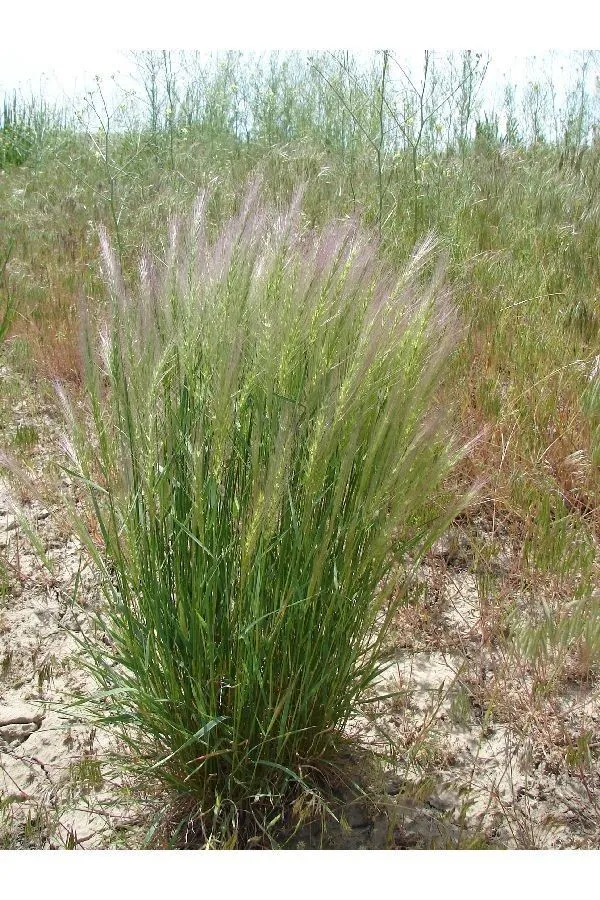
Author: (Raf.) Swezey
Bibliography: Nebraska Fl. Pl.: 15 (1891)
Year: 1891
Status: accepted
Rank: species
Genus: Elymus
Vegetable: False
Observations: W. Canada to W. & C. U.S.A. and Mexico (Coahuila)
The Bottlebrush Squirreltail, known scientifically as Elymus elymoides, is a resilient and essential species of grass within the Poaceae family. First documented in “Nebraska Flora Plants” in 1891, by the botanist Rafinesque and later classified by Swezey, this grass has garnered appreciation for its environmental adaptability and ecological significance.
Elymus elymoides thrives across a diverse range of habitats, extending from Western Canada through the Western and Central United States, and reaching as far south as Coahuila in Mexico. This widespread occurrence speaks to its robustness and ability to colonize various soils and terrains.
The grass earns its common name, Bottlebrush Squirreltail, from its distinctive seed head, which features bristly awns resembling a bottlebrush. These awns can vary in length and density but consistently contribute to the plant’s unique appearance and aid in seed dispersal by hitching rides on passing animals or being carried by the wind.
As a native species, Bottlebrush Squirreltail plays a vital role in its ecosystems. It is often one of the first plants to re-establish itself in disturbed areas, making it invaluable for soil stabilization and recovery after events like wildfires. Additionally, its growth provides a habitat and food source for local wildlife, contributing to the biodiversity and health of its native regions.
In summary, Elymus elymoides is not just a hardy genus of grass but a crucial player in maintaining the balance and vitality of various North American ecosystems. Its adaptability and resilience highlight the plant’s importance in ecological restoration and conservation efforts across its range.
Eng: bottlebrush squirreltail, squirreltail, long-bristled wildrye, common squirreltail, squirreltail grass, western bottlebrush grass
Fra: élyme queue-d’écureuil
En: Bottlebrush squirreltail, Squirreltail, Western Bottle-Brush Grass, Long-bristled wildrye, Common squirreltail, Squirreltail grass, Western bottlebrush grass
Fr: Élyme queue-d’écureuil
Nv: Zééʼiilwoʼii ntsaaígíí
Taken Jun 1, 2019 by Alexander Don Gérémy (cc-by-sa)
Taken Jan 1, 1900 by EOL − John Hilty (cc-by-nc)
Taken Jul 9, 2019 by Bente Hauss (cc-by-sa)
Taken May 13, 2022 by javad rahimian (cc-by-sa)
Taken Sep 7, 2021 by Roxanne Cariadi-Kimbler (cc-by-sa)
Taken Oct 13, 2019 by Céline Liothaud (cc-by-sa)
Taken Aug 4, 2013 by EOL − Terry (cc-by-nc)
Taken Jan 1, 1900 by EOL − John Hilty (cc-by-nc)
Taken Jan 1, 1900 by EOL − John Hilty (cc-by-nc)
Taken Aug 4, 2013 by EOL − Terry (cc-by-nc)
Taken Jan 1, 1900 by EOL − This image is not copyrighted and may be freely used for any purpose. Please credit the artist, original publication if applicable, and the USDA-NRCS PLANTS Database. The following format is suggested and will be appreciated: Cassondra Skinner @ USDA-NRCS PLANTS Database If you cite (public)
Growth form: Bunch
Growth habit: Graminoid
Growth rate: Moderate
Ph maximum: 8.4
Ph minimum: 6.0
Family: Myrtaceae Author: (F.Muell.) K.D.Hill & L.A.S.Johnson Bibliography: Telopea 6: 402 (1995) Year: 1995 Status:…
Family: Rubiaceae Author: Pierre ex A.Froehner Bibliography: Notizbl. Bot. Gart. Berlin-Dahlem 1: 237 (1897) Year:…
Family: Sapindaceae Author: Koidz. Bibliography: J. Coll. Sci. Imp. Univ. Tokyo 32(1): 38 (1911) Year:…
Family: Asteraceae Author: A.Gray Bibliography: Pacif. Railr. Rep.: 107 (1857) Year: 1857 Status: accepted Rank:…
Family: Fabaceae Author: Medik. Bibliography: Vorles. Churpfälz. Phys.-Ökon. Ges. 2: 398 (1787) Year: 1787 Status:…
Family: Aspleniaceae Author: (Cav.) Alston Bibliography: Bull. Misc. Inform. Kew 1932: 309 (1932) Year: 1932…